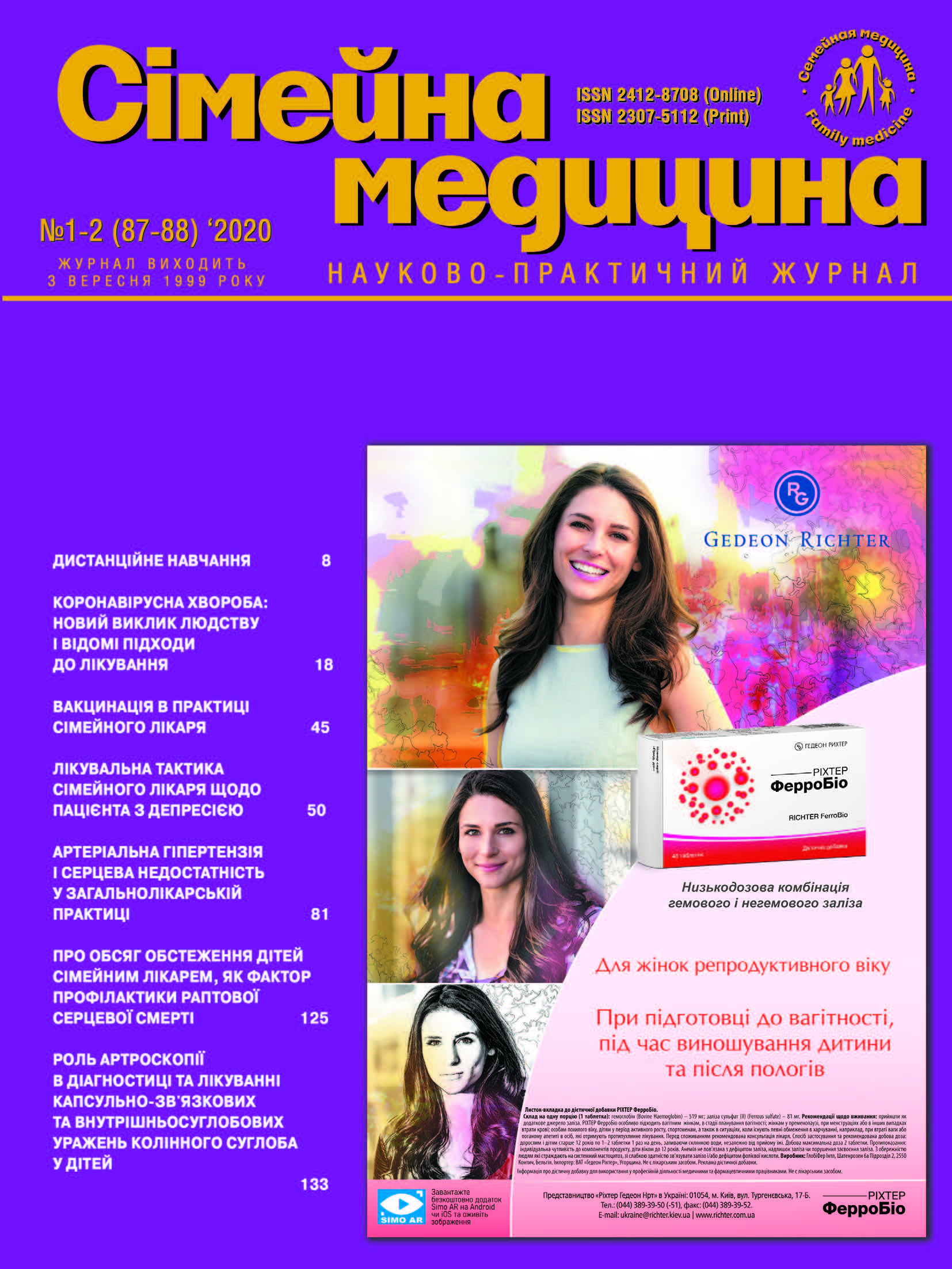Method for Stratification of a Patient with Suspected Urinary Tract Infection for Use of Phytotherapy as an Alternative to the Antibacterial Regimen (by Clinical Trial)
##plugins.themes.bootstrap3.article.main##
Abstract
At the present stage, there is a risk of hyperdiagnosis of urinary tract infection (UTI) in a child with urological signs on an outpatient basis and because of this – the threat of a false diagnosis, abuse of antibacterial therapy (ABT), the development of resistance.
The objective: of the effectiveness of the method of stratification of a child suspected of UTI for the use of herbal medicine with the drug Canephron® N, as an alternative to the antibacterial regimen.
Materials and methods. A prospective clinical study was conducted among outpatient patients suspected of having UTI during 2019. There were 50 children aged 12 to 18 with urological symptoms without signs of a systemic inflammatory response (normal body t, absence of leukocytosis). The observation duration was 90 days. The study was conducted with the informed consent of children and parents per under the Declaration of Human Rights in Helsinki. The method of stratification of the patient’s outpatient plan for antibacterial therapy or phytotherapy was based on the provisions of the National British Guidelines NICE, 2018, by analyzing a fresh urine sample test strips Uriscan U 25, Nephro.
Results. The method of stratification of a patient with urological symptoms to decide on ABT at the outpatient stage has proven its effectiveness and safety. Among patients, 100% clinical recovery and 100% positive laboratory dynamics were noted. Phytotherapy with Canephron® N as an alternative measure has proven its ability in girls 12–18 years with urological symptoms without signs of systemic inflammatory reaction. Yes, 72% ± 8.73 (36/50) confirmed the possibility of using Canephron® N without the use of ABT. On day 7 of phytotherapy, 100% of patients (p<0.05) had a recurrence of dysuria, pain, and leukocyturia. There was a 1.8-fold decrease in the number of patients with bacteriuria (40±20,77 (14/36) vs 22±30,99 (8/36); p<0,05) at the end of 1 week of phytotherapy. The crystallolytic effect of the drug Canephron® N was noted early in therapy (crystalluria level increased by 1.4 times on day 3 of therapy; p>0.05, 2.8 times on day 7; p<0.05). The efficacy and safety of outpatient UTI treatment by prescribing a 7 day phytotherapy course with Canephron® N as an alternative to ABT is demonstrated. Among children with manifestations of UTI, 44% ± 22.57 (11/25) patients recovered after 7 days of therapy. A recurrent episode of UTI at the end of the 3rd month of follow-up after phytotherapy was observed in 9% ± 98 (1/11) patients, which was significantly lower than the mean recurrent UTI rates in children after ABT.
Conclusions. The testing of this method of stratification of a child suspected of UTI, conducted among girls aged 12–18 years, proved its safety and effectiveness. The diagnostic-treatment algorithm developed based on this method can also be applied among children of other age categories with suspected UTI, namely from 3 years of age.
##plugins.themes.bootstrap3.article.details##

This work is licensed under a Creative Commons Attribution 4.0 International License.
Authors retain the copyright and grant the journal the first publication of original scientific articles under the Creative Commons Attribution 4.0 International License, which allows others to distribute work with acknowledgment of authorship and first publication in this journal.
References
Jackson E.C. Urinary tract infections in children: knowledge updates and a salute to the future [Електронний ресурс] / E.C. Jackson // Pediatrics in Review. – 2015. – Vol. 36. doi: 10.1542/pir.36-4-153.
Nicolle LE. The paradigm shift to non-treatment of asymptomatic bacteriuria. Pathogens. 2016;5(2):38. https://doi.org/10.3390/pathogens5020038 Published 2016 Apr 19.
Thomas-White K, Brady M, Wolfe AJ, Mueller ER. The bladder is not sterile: history and current discoveries on the urinary microbiome. Curr Bladder Dysfunct Rep. 2016;11(1):18–24. https://doi.org/10.1007/s11884-016-0345-8
Wagenlehner F, et al. The global prevalence of infections in urology (GPUI) study: a worldwide surveillance study in urology patients. Eur Urol Focus. 2016;2(4):345–7 gpiu.esiu.org/
Antimicrobial Resistance: tackling a crisis for the health and wealth of nations. The review on antimicrobial resistance chaired by Jim O’Neill. 2014.
de Kraker, Marlieke EA, Stewardson AJ, Harbarth S. Will 10 million people die a year due to antimicrobial resistance by 2050? PLoS Med. 2016;13(11):e1002184.
European Association of Urology. EAU guidelines on urological infections. 2019. uroweb.org/guideline/urologicalinfections
Naber K.G., Z. Tandogdu, B. Köves, G. Bonkat, F. Wagenlehner. UTI – quo vadis? New alternatives to treat uncomplicated urinary tract infections. Clinical Phytoscience. – 2019. – Vol. 5. DOI: 10.1186/s40816-019-0132-0
Wagenlehner FM, et al. Non-antibiotic herbal therapy (BNO 1045) versus antibiotic therapy (Fosfomycin Trometamol) for the treatment of acute lower uncomplicated urinary tract infections in women: a double-blind, parallel-group, randomized, multicentre, non-inferiority phase III trial. Urol Int. 2018;101(3):327–36.
Kronenberg, et al. Symptomatic treatment of uncomplicated lower urinary tract infections in the ambulatory setting: randomised, double blind trial. BMJ. 2017;359:j4784 https://doi.org/10.1136/bmj.j4784.
NICE Resource impact report: Urinary tract infection in under 16s: diagnosis and management (CG54): National Institute for Health and Care Excellence; 2018.
Roberts James R Urine Dipstick Testing: Everything You Need to Know. Emergency Medicine News: June 2007. – Vol. 29. – Issue 6. – Р. 24–27. doi: 10.1097/01.EEM.0000279130.93159.d9
Martin Bland An introduction to medical statistics: Oxford University Press, 4th edition. 2015; 464 pp. ISBN 978-0-19-958992-0
Künstle G. et al.. Efficacy of Canephron N against bacterial adhesion, inflammation and bladder hyperactivity. European Association of Urology Congress, Milan 2013, Congress poster 671. 2013.
Nausch B. et al.. Canephron N reduced nociception in experimental cystitis and inhibited the pain-related targets NK1 receptor and ASIC1a. Internationale Tagung Phytotherapie 2014, Winterthur, Schweiz, 18.-21. Juni 2014. Congress poster. 2014.
Finucane TE. «Urinary Tract Infection» – Requiem for a Heavyweight. J Am Geriatr Soc, 2017 Aug 65(8): 1650-1655.
Langdon A, Crook N, Dantas G. The effects of antibiotics on the microbiome throughout development and alternative approaches for therapeutic modulation. Genome Med. 2016;8:39





